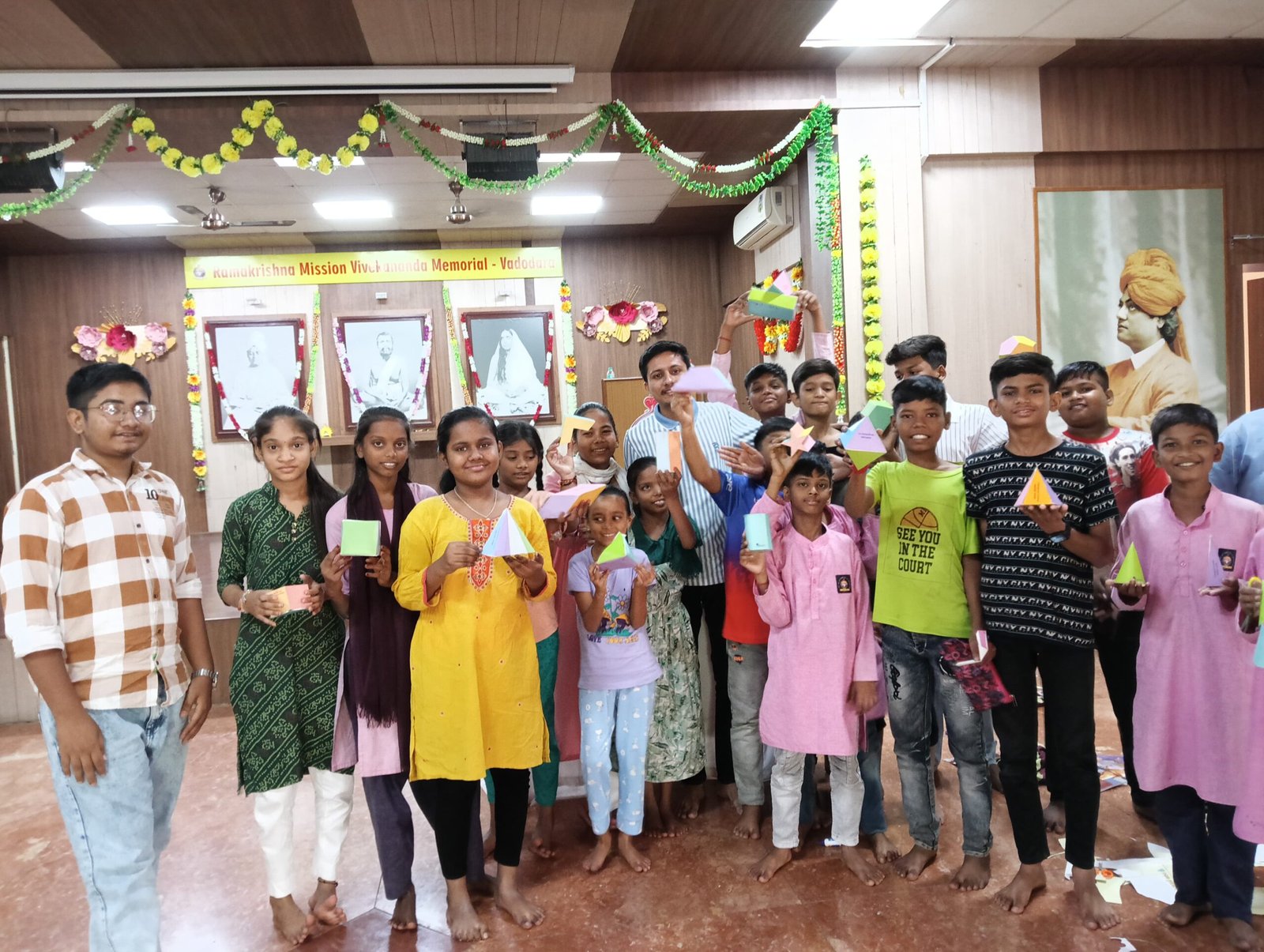
STEM Vadodara 2024
Overview:
The STEM (Science, Technology, Engineering, and Mathematics) program was conducted by Sai’s Angel Foundation (SAF) in partnership with Transpek under their CSR initiative. Running from May 2024 to December 2025, the program aimed to inspire 100 children from the Ramkrishna Mission (Gyanganga Project) and TIL CSR Education Center. SAF provided training to staff, equipped them with STEM kits, and held weekly sessions with fun experiments, promoting critical thinking, creativity, and teamwork. Students gained hands-on experience, helping them build confidence in exploring science and technology.
Module 1: Robotics Games
Students played a soccer game using robotic cars, learning how motors and controllers work. They discovered how robots can be controlled to perform tasks and gained an understanding of the basic principles behind robotics. This fun activity helped them develop teamwork, problem-solving, and technical skills.
Module 2: Solar Car
Students built solar-powered cars and chargers, learning about solar energy and its role in green technology. They also learned about semiconductors, which are essential components in solar panels and many electronic devices. This activity encouraged them to explore renewable energy sources and their potential for a sustainable future.
Module 3: Fun with Chemistry
Students created atom models with clay and conducted experiments with potassium permanganate and glycerin to explore chemical reactions, energy, and fire. This hands-on experience allowed them to understand how chemicals react with each other and the release of energy, making chemistry fun and interactive.
Module 4: Forces and Pressure
In this activity, students built a balloon launcher to understand the concepts of force and pressure. They learned how force is applied and how pressure can move objects. This simple yet engaging experiment helped them connect real-world physics concepts to everyday experiences.
Module 5: Basic Circuit
Students learned how to build circuits using batteries, LEDs, and switches. They explored how current flows in series and parallel circuits, gaining a practical understanding of electrical concepts. This module helped students connect theoretical knowledge to hands-on applications, making learning about electricity exciting.
Module 6: Robotic Assembly
Students assembled a rope robot and learned how motors make it move. They explored the mechanical parts and how they work together to create movement. This hands-on activity introduced them to basic robotics and engineering, allowing them to experiment with real-world applications.
Module 7: Lens and Optics
Students built a periscope and experimented with light, prisms, and lenses to understand how light behaves. They explored the principles of reflection and refraction and how they are used in everyday devices. This activity sparked curiosity about optics and the science behind the movement of light.
Module 8: Area and Shapes
Students created shapes like triangles, hexagons, and circles with paper and measured their areas. They learned how to calculate the area of different shapes, improving their understanding of geometry. This hands-on approach made learning math enjoyable and helped develop spatial reasoning skills.
Module 9: DIY Motor and Magnetism
Students created an electromagnet using a nail and a battery, learning how electricity can generate magnetic fields. They also built a simple motor with copper wire, a battery, and a magnet. This module introduced them to electromagnetism and helped them understand the relationship between electricity and magnetism.
Module 10: Buoyancy
Students made a Cartesian diver using a water bottle, a U-pin, and a straw to explore how objects float or sink. They also conducted experiments to understand buoyancy and gravity, discovering how Archimedes’ principle works in real life. This activity helped students grasp the science of buoyancy in an engaging and hands-on way.
Learning Outcomes from the STEM Program
-
- Enhanced Problem-Solving Skills:
Students developed critical thinking and analytical skills through hands-on experiments and troubleshooting in modules like Robotics Games and Basic Circuits. - Understanding of Renewable Energy:
By building solar-powered cars, students gained knowledge about solar energy, semiconductors, and the importance of green technology in promoting sustainability. - Practical Application of Physics:
Activities like the balloon launcher and Cartesian diver helped students understand key physics concepts such as force, pressure, and buoyancy in real-world contexts. - Teamwork and Collaboration:
Group activities like robotic soccer games encouraged students to work collaboratively, enhancing their communication and interpersonal skills. - Introduction to Robotics and Engineering:
Modules on robotic assembly and motor mechanisms provided a foundational understanding of robotics, engineering principles, and mechanical systems. - Appreciation for Chemistry:
Experiments with chemical reactions fostered curiosity and made abstract concepts like energy release and chemical interactions tangible and exciting. - Improved Spatial and Geometric Reasoning:
The Area and Shapes module strengthened students’ ability to visualize and calculate areas of geometric shapes, linking mathematical theory to practical application. - Hands-On Electrical Knowledge:
By building circuits and electromagnets, students learned how electricity works, including concepts like current flow, series/parallel circuits, and electromagnetism. - Curiosity About Optics:
The Lens and Optics module sparked interest in light behavior, teaching principles of reflection, refraction, and their applications in everyday tools like periscopes.
- Enhanced Problem-Solving Skills:
Increased Confidence in STEM:
Through engaging and practical activities, students gained confidence in exploring STEM subjects, fostering a sense of curiosity and a willingness to learn more about science and technology.
